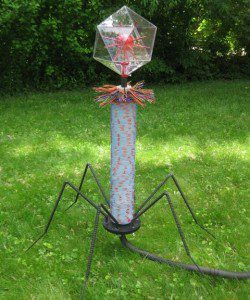

When mice are infected intranasally with Pseudomonas aeruginosa (which causes pneumonia in patients with weak immune systems), the bacterium multiplies in the lungs and kills the animals in less than two days. When a P. aeruginosa lytic phage (i.e. that kills the bacteria) is instilled in the nose of the mice two hours after bacterial infection, all the mice survive and there are no detectable bacteria in the lungs. The phage can even be used prophylactically: it can prevent pneumonia when given up to four days before bacterial challenge.
The ability of phage to clear P. aeruginosa infection in the mouse lungs depends on the innate immune response. When bacteria infect a host, they are rapidly detected by pattern recognition receptors such as toll-like receptors. These receptors detect pathogen-specific molecular patterns and initiate a signaling cascade that leads to the production of cytokines, which may stop the infection. Phage cannot clear P. aeruginosa infection in mice lacking the myd88 gene, which is central to the activity of toll like receptors. This result shows that the innate immune response is crucial for the ability of phages to clear bacterial infections. In contrast, neither T cells, B cells, or innate lymphoid cells such as NK cells are needed for phage therapy to work.
The neutrophil is a cell of the immune system that is important in curtailing bacterial infections. Phage therapy does not work in mice depleted of neutrophils. This result suggests that humans with neutropenia, or low neutrophil counts, might not respond well to phage therapy.
A concern with phage therapy is that bacterial mutants resistant to infection might arise, leading to treatment failure. In silico modeling indicated that phage-resistant bacteria are eliminated by the innate immune response. In contrast, phage resistant bacteria dominate the population in mice lacking the myd88 gene.
These results demonstrate that in mice, successful phage therapy depends on a both the innate immune response of the host, which the authors call ‘immunophage synergy’. Whether such synergy also occurs in humans is not known, but should be studied. Even if observed in humans, immunophage synergy might not be a feature of infections in other anatomical locations, or those caused by other bacteria. Nevertheless, should immunophage synergy occur in people, then clearly only those with appropriate host immunity – which needs to be defined – should be given phage therapy.

Pingback: Phage synergy with the immune system - VETMEDICS
Pingback: Phage synergy with the immune system - Virology